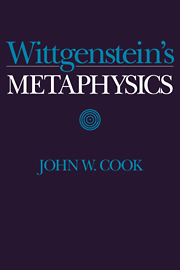Book contents
- Frontmatter
- Contents
- Preface
- List of Abbreviations
- Introduction
- Part I From Idealism to Pure Realism
- Part II The Metaphysics of Wittgenstein's Later Philosophy
- Part III Causation and Science in a Phenomenal World
- Part IV Logical Possibilities and the Possibility of Knowledge
- Part V The Past, Memory, and The Private Language Argument
- 16 Memory, Tenses, and the Past
- 17 Wittgenstein's Analysis of Mental States and Powers
- 18 Following A Rule
- 19 The Private Language Argument
- 20 Names of Sensations and the Use Theory of Meaning
- Name Index
- Subject Index
20 - Names of Sensations and the Use Theory of Meaning
Published online by Cambridge University Press: 05 November 2011
- Frontmatter
- Contents
- Preface
- List of Abbreviations
- Introduction
- Part I From Idealism to Pure Realism
- Part II The Metaphysics of Wittgenstein's Later Philosophy
- Part III Causation and Science in a Phenomenal World
- Part IV Logical Possibilities and the Possibility of Knowledge
- Part V The Past, Memory, and The Private Language Argument
- 16 Memory, Tenses, and the Past
- 17 Wittgenstein's Analysis of Mental States and Powers
- 18 Following A Rule
- 19 The Private Language Argument
- 20 Names of Sensations and the Use Theory of Meaning
- Name Index
- Subject Index
Summary
In the preceding chapter I left unanswered the following question: If we are to reject the idea that words such as “pain” and “itch” are used to refer to what we feel, what did Wittgenstein regard as being the actual ‘grammar’ of these words, i.e., what is the “radical break” (PI, §304) Wittgenstein says we must make? The answer to this question lies in his adoption of Berkeley's ‘use’ theory of meaning.
Berkeley's Use Theory of Meaning
As we saw in Chapter Eight, Berkeley says that, contrary to what is commonly supposed, it is not the chief and only end of language to convey ideas – mental pictures – to the mind of another. Very often, he says, the purpose of saying something to another is, instead, to stir him to (or deter him from) some action, and for this purpose it is frequently unnecessary to convey a mental picture. He declares that if we pay attention to what actually happens, we will find that when we hear or read something said to us, our actions occur immediately “upon the perception of certain words, without any ideas coming between.” His point may be illustrated as follows. As I prepare to leave the house, someone may caution, “It's raining,” and I then take an umbrella without forming a mental picture of falling rain. Or as I am about to test the electric burner on my stove, another person exclaims, “It's hot!” and I instantly pull back my hand without forming an image of heat.
- Type
- Chapter
- Information
- Wittgenstein's Metaphysics , pp. 335 - 342Publisher: Cambridge University PressPrint publication year: 1994



